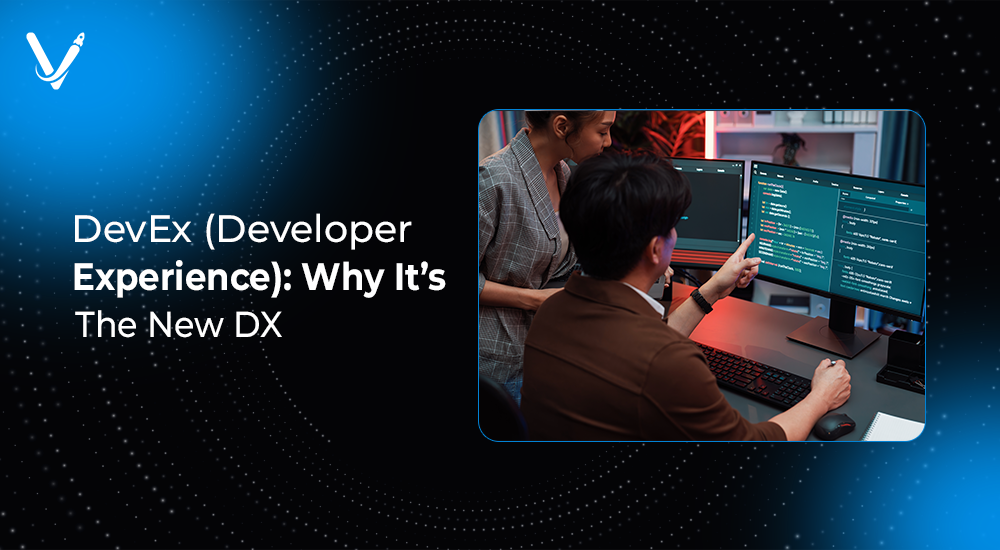DevEx (Developer Experience): Why It’s the New DX


- Jul 29, 2025



Great software isn’t built by code alone—it’s built by developers empowered with clarity, tools, support, and purpose. Yet for too long, the developer's experience has been an afterthought. That’s changing fast.
Today, companies that optimize for Developer Experience (DevEx) aren’t just creating happier engineers—they’re shipping better products faster. DevEx has emerged as a crucial competitive advantage for tech companies in a landscape where talent is scarce, expectations are high, and complexity keeps rising.
This blog will unpack what DevEx really means, how it's different from traditional user experience or DevOps, and why it’s becoming one of the most important KPIs in modern development teams. You'll explore real-world examples, proven strategies, and actionable insights to build a culture where developers thrive and software flows.
Developer Experience refers to the overall experience developers have while building, shipping, and maintaining software. It includes every touchpoint—from onboarding and tooling to documentation, deployment pipelines, and internal collaboration.
In essence, DevEx is about how developers feel about the systems they use daily:
The goal is to remove friction and enable flow.
Several trends are driving the surge in focus on DevEx:
In this climate, every minute a developer spends fighting their tools is a lost opportunity for innovation.
Digital Experience (DX) often refers to the customer-facing experience—how users interact with apps, websites, and services.
DevEx focuses inward: the experience of the people building those digital experiences.
While both aim for smooth journeys, DevEx empowers creators, not consumers.
User Experience optimizes the interface for end-users. Developer Experience optimizes the interface between engineers and their tools, codebase, and teams.
Good UX gets a user to complete a task faster. Good DevEx helps developers do their job with less frustration and more confidence.
DevOps bridges development and operations, focusing on automation, CI/CD, and delivery pipelines.
DevEx is broader—it includes DevOps but also encompasses documentation, onboarding, code reviews, inner sourcing, and even meeting culture.
The best developers work in a state of deep concentration, often referred to as flow. Interruptions and confusing workflows break this state.
Improve DevEx by:
Flow-friendly DevEx translates into faster iterations and higher-quality outputs.
Developers thrive on feedback: does the code work, is the test passing, is the PR approved?
Accelerate DevEx by:
Tighter feedback loops increase confidence, reduce guesswork, and empower experimentation.
An overloaded developer is a disengaged developer.
Enhance comfort by:
Comfort isn’t about luxury—it’s about cognitive efficiency.
Google has long been a DevEx pioneer. Their internal team focuses on reducing build times, test flakiness, and tool inconsistencies.
Key outcomes:
Spotify built Backstage, an open-source developer portal that consolidates microservices, documentation, and tools in one place.
Impact:
GitHub Copilot, powered by OpenAI, offers context-aware code suggestions.
Benefits:
These platforms prove that DevEx is not a luxury—it’s a business driver.
Monitoring Developer Experience requires thoughtful KPIs, including:
Use these to identify friction points and improve DevEx iteratively.
Early-stage companies benefit from lightweight DevEx:
Startups win by keeping developers close to the customer and minimizing red tape.
Larger organizations must balance autonomy with consistency.
The larger the team, the more valuable good DevEx becomes.
Too many tools with overlapping functionality confuse developers.
Fix: Consolidate tooling and choose opinionated defaults.
Developers lose hours when they can’t find answers.
Fix: Maintain living documentation and use internal search engines.
Tightly controlled deployments or access to infrastructure can slow down innovation.
Fix: Embrace self-service and encourage internal open source (InnerSource).
What you measure may not reflect actual pain points.
Fix: Pair surveys with one-on-one interviews or anonymous Slack channels.
Understand the daily struggles developers face. Ask:
Use this data to prioritize improvements.
Great DevEx needs more than off-the-shelf tools. Build internal solutions that:
Make onboarding predictable and fun.
Enable developers to grow alongside your stack.
AI is redefining Developer Experience. Future-forward teams are:
Platforms like Replit Ghostwriter, Amazon CodeWhisperer, and Tabnine are already embedding AI into the developer workflow.
As AI matures, DevEx will shift toward hyper-personalized tooling, where environments adapt to the developer’s habits, preferred languages, and goals.
Developer Experience is no longer just a nice-to-have—it’s your competitive edge in the battle for innovation, velocity, and engineering talent.
When you invest in DevEx, you’re investing in:
At Vasundhara Infotech, we help teams reimagine their development process. From platform engineering to AI-powered tooling, we build custom solutions that empower your engineers to create, iterate, and ship at scale—with joy.
Ready to level up your DevEx? Let’s build the future of development together.
Copyright © 2026 Vasundhara Infotech. All Rights Reserved.